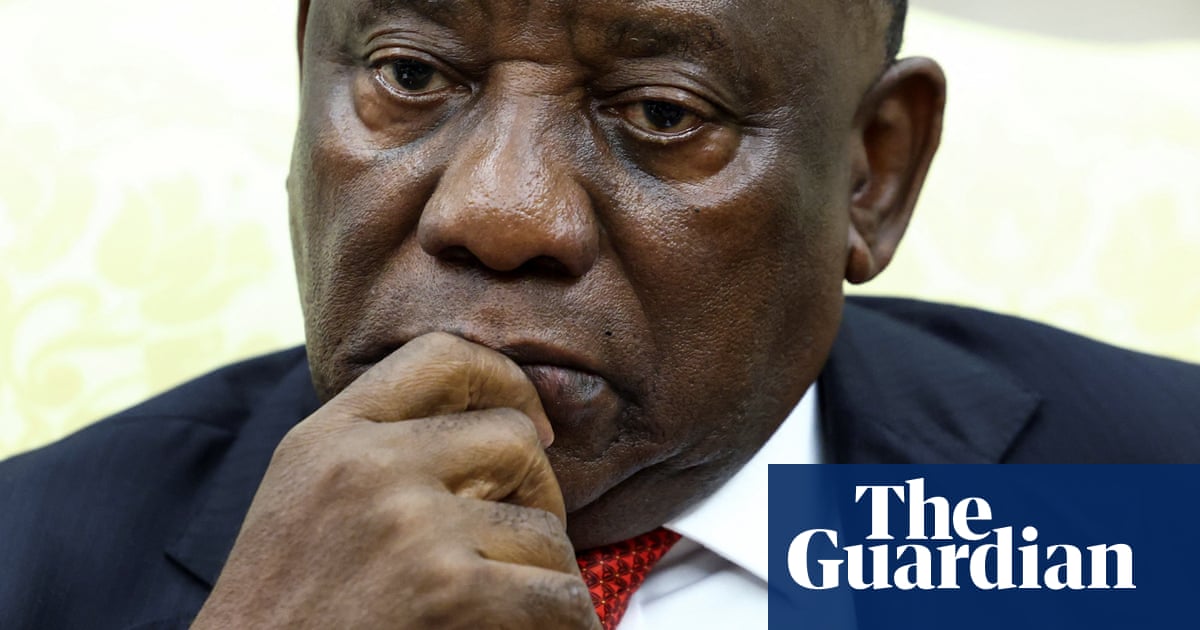Many South Africans praised their president Cyril Ramaphosa for staying calm when Donald Trumpambushed him in the Oval Officewith a video purporting to back up his false claims of a “genocide” against white Afrikaner farmers.
Others asked why Ramaphosa, who brought ministers, golfers and a billionaire with him, chose to walk into what he knew was likely to be a trap.
Before the televised encounter, US-South Africa relations were at a nadir. In February, Trumpsigned an executive ordercutting aid to South Africa, accusing it of “unjust racial discrimination” against Afrikaners, who ruled the country during apartheid, which repressed the non-white majority.
The order set up a programme to bring Afrikaners to the US as refugees, with the first grouparriving earlier this monthwhile the US blocked other refugees from war zones.
“There is criminality in our country. People who do get killed, unfortunately through criminal activity, are not only white people. The majority of them are black people,” Ramaphosa told Trump, who hit back: “The farmers are not black.”
Ramphosa later returned to Trump’s divisive claims, saying: “These are concerns that we are willing to talk to you about.”
“President Ramaphosa did well to maintain a calm demeanour and he did well to stick to the facts as close as possible,” the political journalist Pieter du Toit told Reuters.
Some social media users noticed Ramaphosa grinning when Trump’s video featured far-left opposition politician Julius Malema singing the controversial anti-apartheid song Kill the Boer (Boer, meaning farmer in Afrikaans, also refers to Afrikaners).
“Cyril can’t even contain his laughter … yhooooooo cupcake,” one userposted on X, using apopularteasing nickname for South Africa’s president that first spread in 2017, when it appeared in leaked emails from alleged mistresses of the then deputy president. (Ramaphosaadmittedhe had had an affair and suggested the emails had been doctored, but nowrespondsto the nickname.)
The White House video ended with an aerial shot of white crosses lining a rural road, which Trump said marked the burial sites of “over 1,000 white farmers”.
The crosses were actually erected as a temporary protest after the murder of white couple Glenn and Vida Rafferty on their farm in 2020. “It’s not a burial site … it was a memorial,” Rob Hoatson, a neighbour of the Rafferty’s and one of the protest organisers,told the BBC.
Another image presented by Trump as evidence of a “white genocide” was actually a still from a video taken in the Democratic Republic of the Congo (DRC).
“These are all white farmers that are being buried,” said Trump, as he brandished a printout with a picture of body bags being lifted into a grave. But Reuters reported on Thursday that the image was actually a still from a 3 February report by the agency showing the aftermath of fighting the DRC army and Rwanda-backed M23 rebels.
In South Africa, almost 2,300 farmers, their families and workers have been killed since 1990, according to figures from the Transvaal Agricultural Union, a conservative mainly Afrikaner farmers group,cited by AFP. Last year, South African police recorded more than 26,000 murders. Experts say the often-fatal armed robberies target people for their cash and valuables, not their race.
The presence of the golfers Ernie Els and Retief Goosen appeared to warm Trump toSouth Africaat times, with him referring to them as “friends”.
Many South Africans were less impressed.
Some flagged that Els’s “two wrongs don’t make a right” comment seemed to equate apartheid with the shortcomings of black-led democratic governments, while othersraised eyebrowsat him thanking the US for supporting the apartheid regime’s war with Angola. Goosen spoke about his brothers’ “constant battle” to stop their farms from being taken over, although he added that his family had a “great life” in South Africa.
At a press conference after the Oval Office meeting, reporters questioned why the golfers had attended and if they had been briefed beforehand. Ramaphosa said there hadn’t been time to do so, adding: “It is what it is … Those golfers are patriotic South Africans.”
Johann Rupert, the white founder of the luxury goods group Richemont, which owns Cartier, was praised by many South Africans for pointing out that all races suffer from violent crime.
However, the billionaire is also a lightning rod for discontent about the country’s searing inequality, with his inclusion in the delegation seen by some as a capitulation to the forces of both racism and capitalism.
And it did not escape the notice of South Africans, who are finely attuned to racial dynamics, that while Trump repeatedly interrupted Ramaphosa, he did not once speak over Rupert or the white golfers.
